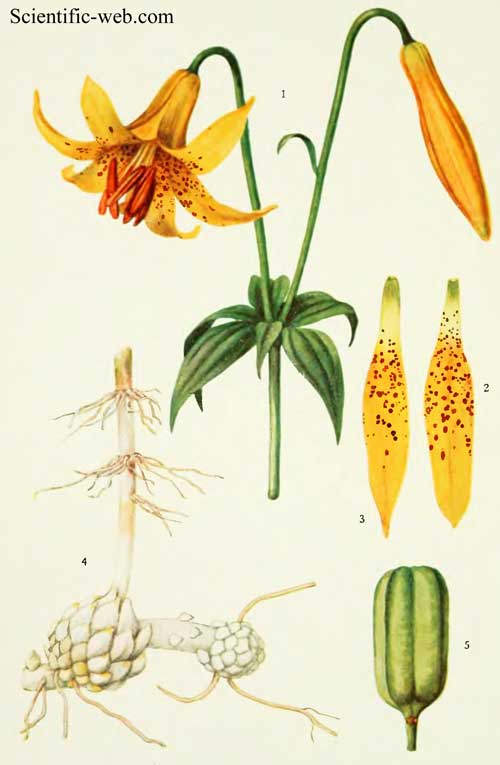
Lilium canadense
Classification System: APG IV
Superregnum: Eukaryota
Regnum: Plantae
Cladus: Angiosperms
Cladus: Monocots
Ordo: Liliales
Familia: Liliaceae
Subfamilia: Lilioideae
Genus: Lilium
Sectio: L. sect. Pseudolirium
Species: Lilium canadense
Name
Lilium canadense L., Sp. Pl.: 303. 1753.
Synonyms
Lilium canadense f. flavum (Pursh) Vict., Contr. Lab. Bot. Univ. Montréal 14: 15. 1929.
Lilium canadense f. peramoenum (Farw.) B.Boivin & Cody, Rhodora 58: 18. 1956).
Lilium canadense f. rubrum Britton, Bull. Torrey Bot. Club 17: 125. 1890.
Lilium canadense var. coccineum Pursh, Fl. Amer. Sept. 1: 229. 1813.
Lilium canadense var. editorum Fernald, Rhodora 45: 393. 1943.
Lilium canadense var. flavum Pursh, Fl. Amer. Sept. 1: 229. 1813.
Lilium canadense var. hartwegii Baker, Gard. Chron. 1871: 1165. 1871.
Lilium michiganense f. peramoenum (Farw.) Stoker, Lily Year-Book 4: 24. 1935.
Lilium penduliflorum DC. in P.J.Redouté, Liliac. 2: t. 105. 1805.
Lilium pendulum Spae, Mém. Couronnés Mém. Savants Étrangers Acad. Roy. Sci. Bruxelles (4to) 19(5): 28. 1847.
Lilium peramoenum Farw., Bull. Torrey Bot. Club 42: 354. 1915.
Lilium philadelphicum subsp. editorum (Fernald) Wherry, Bartonia 24: 7. 1947.
Lilium pulchrum Salisb., Prodr. Stirp. Chap. Allerton: 237. 1796.
Notes
Mark W. Skinner does not accept subspecific taxa.
References
Mark W. Skinner. Flora of North America. Efloras. 2009 Jul 26 [1].
Vernacular names
svenska: Kanadalilja
Lilium canadense, commonly called either the Canada lily,[3][4] wild yellow-lily, or the meadow lily, is a native of eastern North America.[5] Its native range extends from Ontario to Nova Scotia south to Georgia and Alabama. It is most common in New England, the Appalachian Mountains, and the Canadian Maritimes.[6] It is also cultivated as an ornamental in Europe and other places.[7]
Flowers emerge in June. They are nodding (hanging downward), yellow, orange or red, often with darker spots. The plant has become less common in urban and suburban areas due to heavy browsing by the white-tailed deer.
Description
These plants usually live in moist meadows and wood margins. They can grow up to 0.5-1.5m with yellow, orange or red flowers 50–75 mm wide which emerge between June and July.
Culinary uses
The flower buds and roots traditionally gathered and eaten by North American indigenous peoples.[8]
Conservation status in the United States
It is listed Rare in Indiana, as Exploitably Vulnerable in New York (state), and as Threatened in Rhode Island and Tennessee.[9]
References
illustration from "A selection of Hexandrian plants, belonging to the natural orders Amaryllidae and Liliacae from Zeichnungen" by Mrs. Edward Bury, Liverpool; painted by R. Havell, circa 1870
"Lilium canadense". World Checklist of Selected Plant Families (WCSP). Royal Botanic Gardens, Kew.
BSBI List 2007 (xls). Botanical Society of Britain and Ireland. Archived from the original (xls) on 2015-06-26. Retrieved 2014-10-17.
USDA, NRCS (n.d.). "Lilium canadense". The PLANTS Database (plants.usda.gov). Greensboro, North Carolina: National Plant Data Team. Retrieved 25 January 2016.
Skinner, Mark W. (2002). "Lilium canadense". In Flora of North America Editorial Committee (ed.). Flora of North America North of Mexico (FNA). Vol. 26. New York and Oxford – via eFloras.org, Missouri Botanical Garden, St. Louis, MO & Harvard University Herbaria, Cambridge, MA.
"Lilium canadense". County-level distribution map from the North American Plant Atlas (NAPA). Biota of North America Program (BONAP). 2014.
Alpine Garden Society
Boreal Forest, Faculty of Natural Resources Management, Lakehead University, Lilium canadense, Canada Lily
USDA, NRCS (n.d.). "Lilium canadense". The PLANTS Database (plants.usda.gov). Greensboro, North Carolina: National Plant Data Team. Retrieved 31 May 2018.
Retrieved from "http://en.wikipedia.org/"
All text is available under the terms of the GNU Free Documentation License

